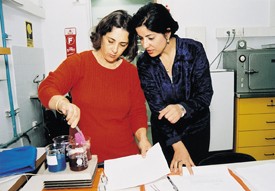Are you a journalist? Please sign up here for our press releases
Subscribe to our monthly newsletter:

Want to convey an earthy/natural look or one of quiet prestige and sophistication? Colors have a profound influence on our impressions, emotions, and at times even on the choices we make - which explains why advertisers carefully consider color in developing marketing strategies, and why most interior designers wouldn't paint a restaurant blue, generally considered an appetite suppressant. Yet despite their far-reaching effects most of us give little thought to how different colored paints are made and used - for instance, how car paints are formulated to withstand corrosion. A new program at the Weizmann Institute of Science may change all this.
Paints - A Way to Industrial Systems is part of a comprehensive curriculum developed in response to a call by Israel's Ministry of Education for new learning materials emphasizing the connection between science, technology, and society,' says Prof. Bat-Sheva Eylon of the Institute's Science Teaching Department. Eylon heads an innovative learning program called MATMON (Hebrew for 'treasure,' but also an acronym for Science and Technology at the Weizmann Institute). 'The idea is to develop educational programs in which students explore themes in science and technology in a way that is fun, meaningful, and linked to their everyday surroundings. For example, Senses and Sensors, another teaching unit developed by our staff, brings together biology, physics, and technology, addressing sensory mechanisms in humans and animals and examining their similarity to sensors used in applications as diverse as electronics, industrial quality control, and military surveillance.
But back to color. Paints, a unit, designed for junior-high students by Dr. Miri Kesner and Liora Saar, starts with a story. It's built around a group of kids looking for a way to paint their clubhouse. Chalk, glue, hibiscus flowers, carrots, and cabbage all find their way to the students' lab benches as they explore the chemistry of paints, learn how pigments from flowers, vegetables, and even snails were used in antiquity to create different shades, and grapple with issues of quality control and environmental pollution.
And how does all this apply to everyday life? The students learn about pigments by dropping in on their neighborhood laundromat, experiment with creating custom-made paints at a nearby hardware store, or visit a marble factory. To gain a feel for the problems faced in transferring scientific discoveries to large-scale industrial production, the students bake bread - lots of it! They then divide into groups and move on to more in-depth learning about the world of industry, with each group specializing in a topic of their choice. 'In addition to content learning, the unit aims to develop important inquiry, problem-solving, and even presentation and marketing skills,' says team leader Dr. Zahava Scherz. 'The students acquire information through different sources; they interview content experts, learn how to analyze experimental results, and engage in peer teaching, using various creative means to convey their findings to fellow classmates.'
MATMON backs its new educational materials with teacher training seminars offered at the Institute and sends out teams to schools throughout the country to help smooth the programs' first steps in the classroom and receive feedback from teachers and students alike. Visits to Arab schools in the north of Israel revealed the need for a special training seminar to prepare a contingent of leading Arab science teachers that will spearhead the new emphasis upon science and technology in the Arab sector. In response, MATMON members Dr. Yehuda Ben Hur and Varda Shilo set up a three-year training course, consisting of one study day per week in the city of Shfaram, as well as a week-long intensive seminar at the Institute, offered for the first time last summer. During the week the teachers attended lectures, participated in a fabric-dyeing workshop, and undertook a scientific investigation project.
Program participant Fitna Zuabi, a junior-high science teacher from Nazareth, later prepared an impressive exhibition with her students that attracted the attention of local policy makers. 'Students are really excited about the new materials, which encourage learning through experience, ' says Zuabi. 'In addition to science learning, the students explored the social aspects of colors. For instance, one group worked with the school psychologist in creating a questionnaire to study the connection between colors and emotions, while another prepared marketing strategies, examining the relationship between colors and products, such as which car colors sell best.'